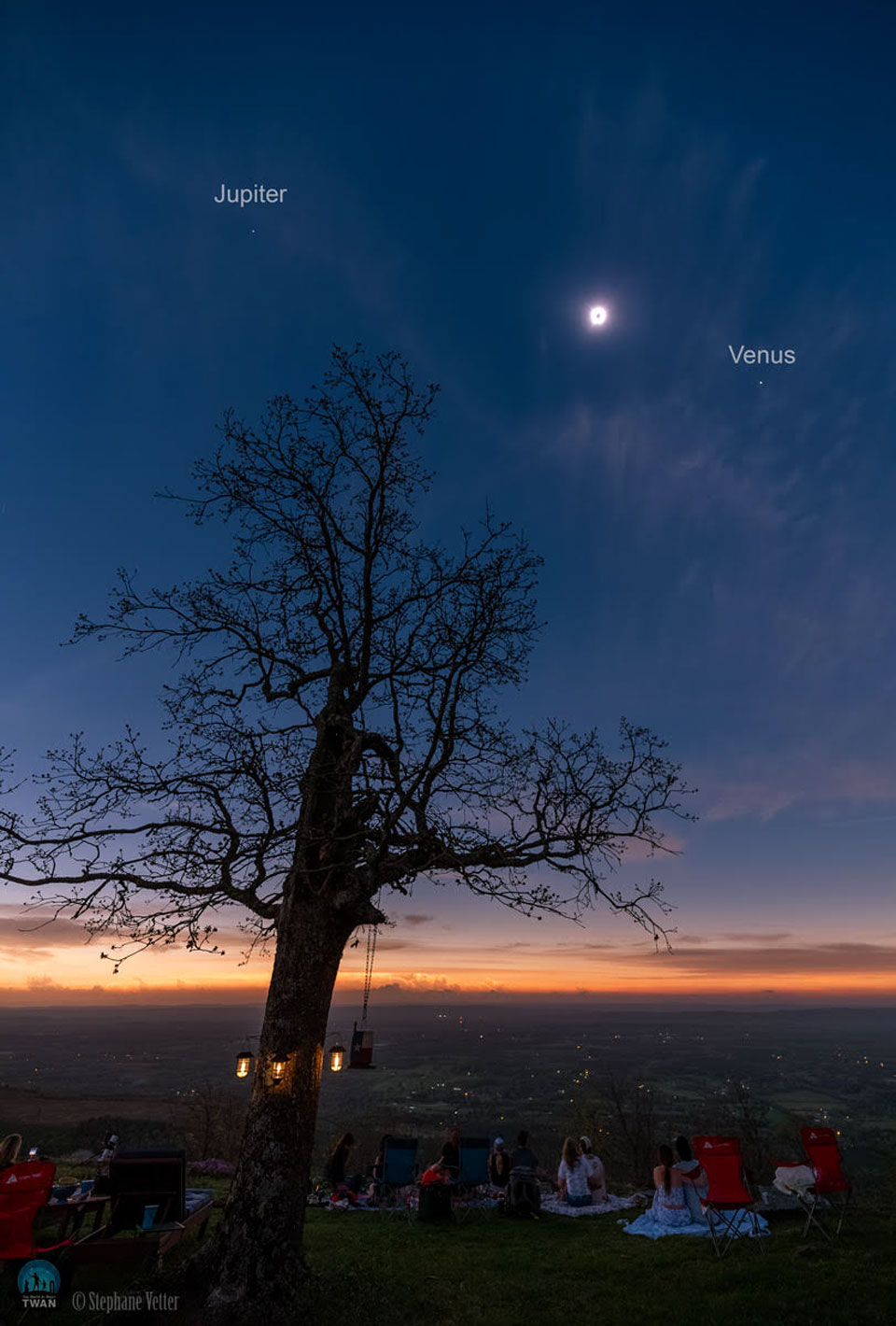10. April 2024
日全食 kah 伊邊仔 ê 行星

探索宇宙1!逐工會揀一幅無仝款 ê 影像抑是相片,𤆬你熟似咱這个迷人 ê 宇宙,閣有專業天文學者2為你3解說4。
- 原始文章:Planets Around a Total Eclipse
- 影像來源:Stéphane Vetter (Nuits sacrées)
- 拜一 ê 日食相簿:Notable Submissions to APOD
- 台文翻譯:An-Li Tsai (NSYSU)
[漢羅] 日全食 kah 伊邊仔 ê 行星
月娘若是 kā 日頭閘去,會出現啥物款 ê 景色? Tùi 足濟期待 tī 美國時間 4 月 8 號(台灣時間已經是 9 號矣)ê 日全食 觀星者來講,tī 忽然間變暗去 ê 天色內底,咱會當看著 ê 景色,包括 日冕 kah 可能看會著 ê 兩粒行星:金星 kah 木星。 正常講來,最近 ê 金星干焦會當 tī 透早時、抑就是日頭 kah 木星攏 tī 地平線下底才看會著,木星是暗暝足光 ê 一粒星。 拜一 ê 時陣(台灣時間已經是拜二翻點矣),若是有徛 tiàm 適當 ê 所在,就會當 tī 日全食 ê 日時,看著兩粒行星 kah 食日 排排做一逝。 這个排排做一逝 ê 景色是 tī 拜一下晡 tiàm 美國 Arkansas 州 Nebo 山 翕--ê,相片內底閣有翕著 好奇 ê 觀星者、kah 媠形 ê 樹仔。
[POJ] Ji̍t-choân-si̍t kah I piⁿ-á ê Kiâⁿ-chheⁿ
Goe̍h-niû nā-sī kā ji̍t-thâu cha̍h khì, ē chhut-hiān siáⁿ-mih-khoán ê kéng-sek? Tùi chiok chē kî-thāi tī Bí-kok-sî-kan 4 goe̍h 8 hō (Tâi-oân sî-kan í-keng sī 9 hō ah) ê ji̍t-choân-si̍t koan-seng-chiá lâi-kóng, tī hut-jiân-kan piàn àm--khì ê thiⁿ-sek lāi-té, lán ē-tàng khòaⁿ--tio̍h ê kéng-sek, pau-koat ji̍t-bián kah khó-lêng khòaⁿ-ē-tio̍h ê nn̄g lia̍p kiâⁿ-chheⁿ: Kim-chheⁿ kah Bo̍k-chheⁿ. Chèng-siông kóng-lâi, chòe-kīn ê Kim-chheⁿ kan-na ē-tàng tī thàu-chá-sî, ia̍h tio̍h-sī ji̍t-thâu kah Bo̍k-chheⁿ lóng tī tē-pêng-sòaⁿ ē-té chiah khòaⁿ-ē-tio̍h, Bo̍k-chheⁿ sī àm-mê chiok kng ê chi̍t-lia̍p chheⁿ. Pài-it ê sî-chūn (Tâi-oân sî-kan í-keng sī pài-lī hoan-tiám--ah), nā-sī ū khiā tiàm sek-tong ê só͘-chāi, to̍h ē-tàng tī ji̍t-choân-si̍t ê ji̍t-sî, khòaⁿ-tio̍h nn̄g lia̍p kiâⁿ-chheⁿ kah si̍t-ji̍t pâi-pâi chò chi̍t-chōa. Chit-ê pâi-pâi chò chi̍t-chōa ê kéng-sek sī tī pài-it ē-po͘ tiàm Bí-kok Arkansas chiu Nebo soaⁿ hip--ê, siòng-phìⁿ lāi-té koh-ū hip-tio̍h hòⁿ-kî ê koan-seng-chiá, kah súi-hêng ê chhiū-á.
[KIP] Ji̍t-tsuân-si̍t kah I pinn-á ê Kiânn-tshenn
Gue̍h-niû nā-sī kā ji̍t-thâu tsa̍h khì, ē tshut-hiān siánn-mih-khuán ê kíng-sik? Tuì tsiok tsē kî-thāi tī Bí-kok-sî-kan 4 gue̍h 8 hō (Tâi-uân sî-kan í-king sī 9 hō ah) ê ji̍t-tsuân-si̍t kuan-sing-tsiá lâi-kóng, tī hut-jiân-kan piàn àm--khì ê thinn-sik lāi-té, lán ē-tàng khuànn--tio̍h ê kíng-sik, pau-kuat ji̍t-bián kah khó-lîng khuànn-ē-tio̍h ê nn̄g lia̍p kiânn-tshenn: Kim-tshenn kah Bo̍k-tshenn. Tsìng-siông kóng-lâi, tsuè-kīn ê Kim-tshenn kan-na ē-tàng tī thàu-tsá-sî, ia̍h tio̍h-sī ji̍t-thâu kah Bo̍k-tshenn lóng tī tē-pîng-suànn ē-té tsiah khuànn-ē-tio̍h, Bo̍k-tshenn sī àm-mê tsiok kng ê tsi̍t-lia̍p tshenn. Pài-it ê sî-tsūn (Tâi-uân sî-kan í-king sī pài-lī huan-tiám--ah), nā-sī ū khiā tiàm sik-tong ê sóo-tsāi, to̍h ē-tàng tī ji̍t-tsuân-si̍t ê ji̍t-sî, khuànn-tio̍h nn̄g lia̍p kiânn-tshenn kah si̍t-ji̍t pâi-pâi tsò tsi̍t-tsuā. Tsit-ê pâi-pâi tsò tsi̍t-tsuā ê kíng-sik sī tī pài-it ē-poo tiàm Bí-kok Arkansas tsiu Nebo suann hip--ê, siòng-phìnn lāi-té koh-ū hip-tio̍h hònn-kî ê kuan-sing-tsiá, kah suí-hîng ê tshiū-á.
[English] Planets Around a Total Eclipse
What wonders appear when the Moon blocks the Sun? For many eager observers of Monday’s total eclipse of the Sun, the suddenly dark sky included the expected corona and two (perhaps surprise) planets: Venus and Jupiter. Normally, in recent days, Venus is visible only in the morning when the Sun and Jupiter are below the horizon, while Jupiter appears bright only in the evening. On Monday, though, for well-placed observers, both planets became easily visible during the day right in line with the totally eclipsed Sun. This line was captured Monday afternoon in the featured image from Mount Nebo, Arkansas, USA, along with a line of curious observers — and a picturesque tree.
詞彙學習
| 漢羅 | POJ | KIP | 華語 | English |
|---|---|---|---|---|
| 日全食 | ji̍t-choân-si̍t | ji̍t-tsuân-si̍t | 日全食 | total solar eclipse |
| 日冕 | ji̍t-bián | ji̍t-bián | 日冕 | corona |
| 金星 | kim-chheⁿ | kim-tshenn | 金星 | Venus |
| 木星 | Bo̍k-chheⁿ | Bo̍k-tshenn | 木星 | Jupiter |
| 食日 | si̍t-ji̍t | si̍t-ji̍t | 食日 | eclipsed Sun |
| 翻點 | hoan-tiám | huan-tiám | 過午夜十二點 | after midnight |